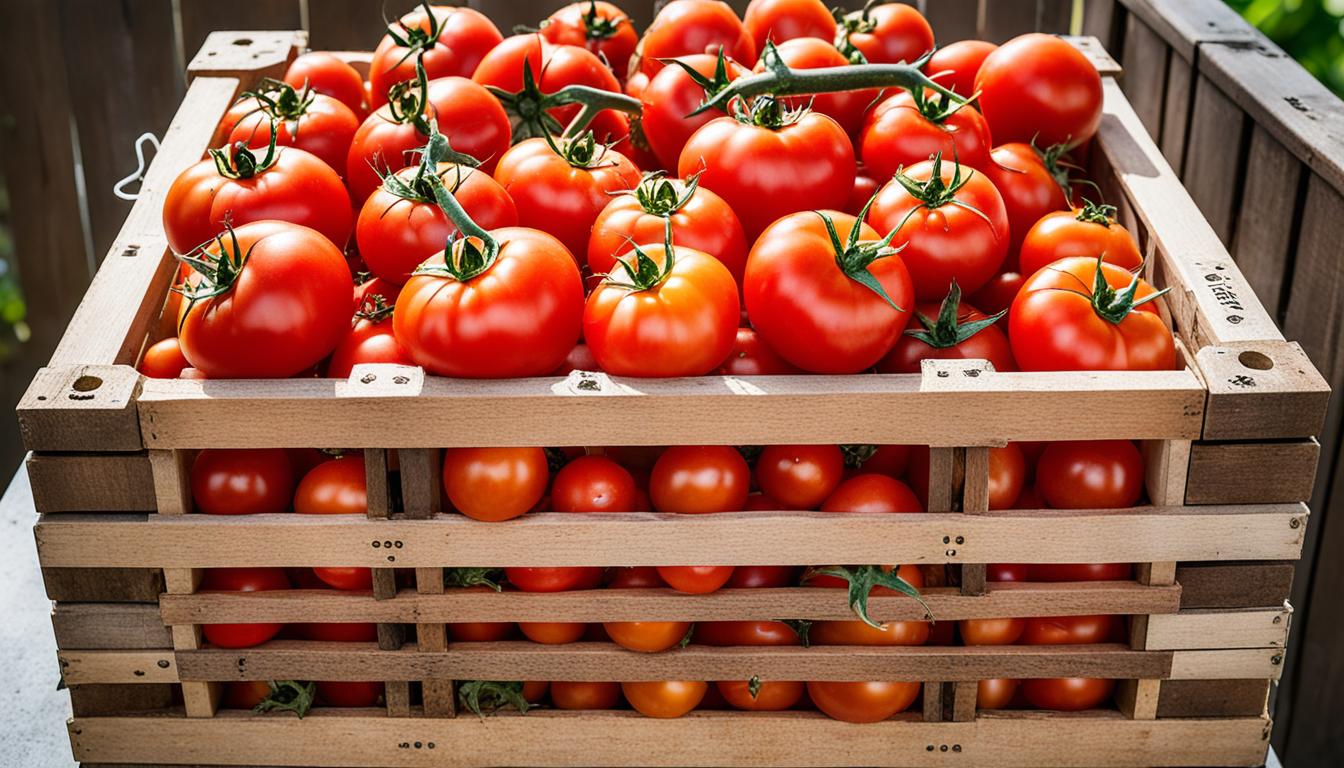The United States makes over $2 billion from tomatoes every year. It’s a big deal for tomato lovers. But, tomatoes are easy to spoil, which is a big problem. We need to keep them fresh and safe to eat.
Food safety is a big worry with tomatoes. Many people get sick from bad tomatoes. So, we must find ways to keep tomatoes good for longer.
But what’s the best way to keep tomatoes fresh? How can we stop them from going bad? Let’s find out.
Key Takeaways
- The U.S. is the world’s largest tomato producer, generating $2 billion in annual receipts.
- Tomatoes are highly perishable and susceptible to spoilage, leading to significant food waste.
- Proper storage techniques can extend the shelf life of tomatoes and maintain their flavor and quality.
- Avoiding contamination and damage during harvesting and storage is crucial to preventing spoilage.
- Implementing best practices for cleaning, temperature/humidity control, and storage containers can help preserve tomatoes.
Introduction
Storing tomatoes right is key to keeping them fresh and preventing them from going bad. If you don’t handle and store them well, they can get moldy, lose their taste, and ripen too fast. This article will show you how to harvest, clean, store, and preserve tomatoes. This way, you can enjoy them for a longer time.
Importance of Proper Tomato Storage
Tomatoes are very delicate and a lot of them get thrown away before people even eat them. If you store them wrong, they can get mold and even make you sick with germs like Staphylococcus, Bacillus, and Escherichia coli. Also, the wrong temperature can make tomatoes taste bad and lose their nutrients.
Overview of Best Practices
To keep tomatoes fresh and tasty, you need to follow some important steps. This includes how to pick them, store them, and keep them fresh. Doing these things helps you avoid waste and have good tomatoes for a longer time.
The main steps are:
- Picking tomatoes when they are ripe
- Checking tomatoes for damage before storing them
- Cleaning and drying tomatoes before putting them away
- Keeping the right temperature and humidity for storage
- Using the right containers and keeping them away from fruits that make ethylene
- Checking on tomatoes often for any signs of going bad and using the oldest ones first
- Looking into ways to preserve tomatoes like canning, freezing, or vacuum sealing
- Keeping the storage area clean and germ-free
By doing these things, you can cut down on tomatoes going bad, keep them fresh, and have a steady supply of good tomatoes. The next parts will give you more details on each step to help you store and preserve tomatoes better.
1. Harvesting at the Right Time
Timing is key when picking tomatoes. Picking them when they are ripe is important. This helps avoid waste and makes sure they taste great. Knowing when tomatoes are ready and how to handle them helps you store them well.
Identifying Optimal Ripeness
Look for ripe tomatoes by their color and feel. They should be fully colored and have no marks. They should also be firm but give a bit when pressed. Don’t pick tomatoes that are on the ground or look damaged.
For cherry tomatoes, wait until they are fully red to avoid problems. Also, watch out for cool days that stop tomatoes from ripening. This means you might need to pick them sooner.
Avoiding Damage During Harvest
Be gentle when picking tomatoes to avoid bruises. Hold them under the fruit and don’t pull the stem. Use clean, sharp tools to cut them from the vine.
Tomatoes that get hurt during picking spoil faster. So, handle each one carefully. By doing this, you’ll keep your tomatoes fresh for a long time.
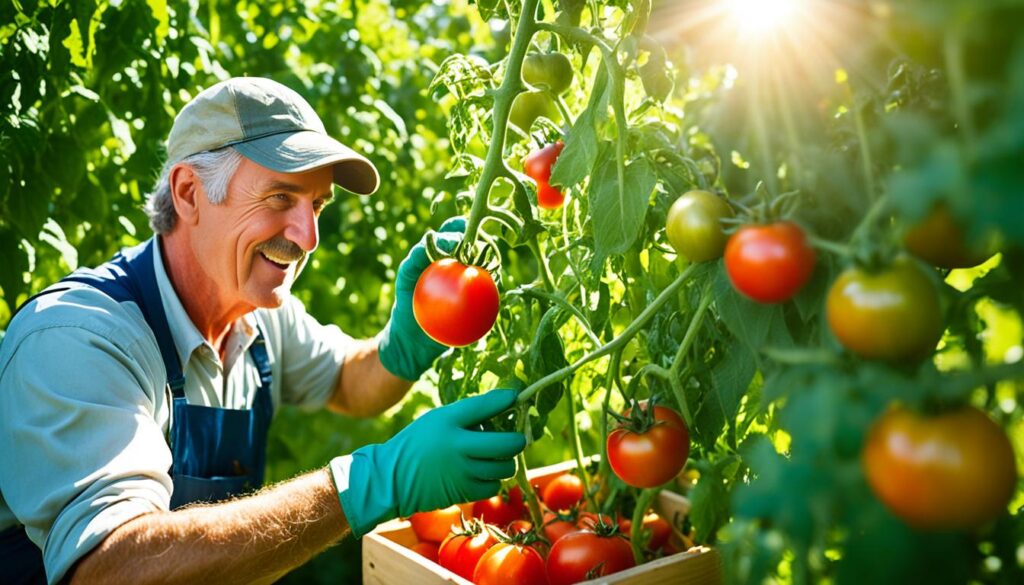
2. Inspecting and Sorting Tomatoes
Storing tomatoes starts with a close check of each one after picking. Look for bruises, blemishes, or damage that could make them spoil faster. Damaged tomatoes can spread germs and ruin the whole batch. So, it’s key to separate them from the good ones.
Checking for Bruises and Blemishes
Run your fingers over each tomato to find soft spots, cuts, or color changes. Check the stem and blossom ends closely. These parts often get damaged. If you see bruises, cracks, pests, or disease, use them right away or throw them out.
Separating Damaged Tomatoes from Healthy Ones
After finding the damaged tomatoes, keep them away from the good ones. This stops germs from spreading. Use different containers or areas for the healthy and damaged tomatoes.
Inspecting and sorting your tomatoes carefully helps them last longer and stay fresh. A little effort upfront keeps your tomatoes tasty for more time.
For more tips on handling tomato diseases, pests, and problems, check out these resources:
3. Proper Cleaning Techniques
Keeping tomatoes fresh and safe starts with cleaning them right. You need to wash and dry them well to get rid of dirt and germs. This keeps the tomatoes safe to eat.
Washing Tomatoes Correctly
Use clean water that’s a bit warmer than the tomatoes when washing them. This stops germs from getting into the fruit. Use a soft cloth or brush to clean them, but don’t hurt the skin.
Drying Tomatoes Thoroughly
After washing, dry the tomatoes well before storing them. Moisture can make mold and bacteria grow, which can ruin the tomatoes. Dry them with a clean towel or paper towels, making sure to get all the water off.
By cleaning your tomatoes right, they’ll stay fresh longer and be safer to eat. Keeping things clean when you handle and store tomatoes is key to avoiding contamination. This helps keep your tomatoes good to eat for a longer time.
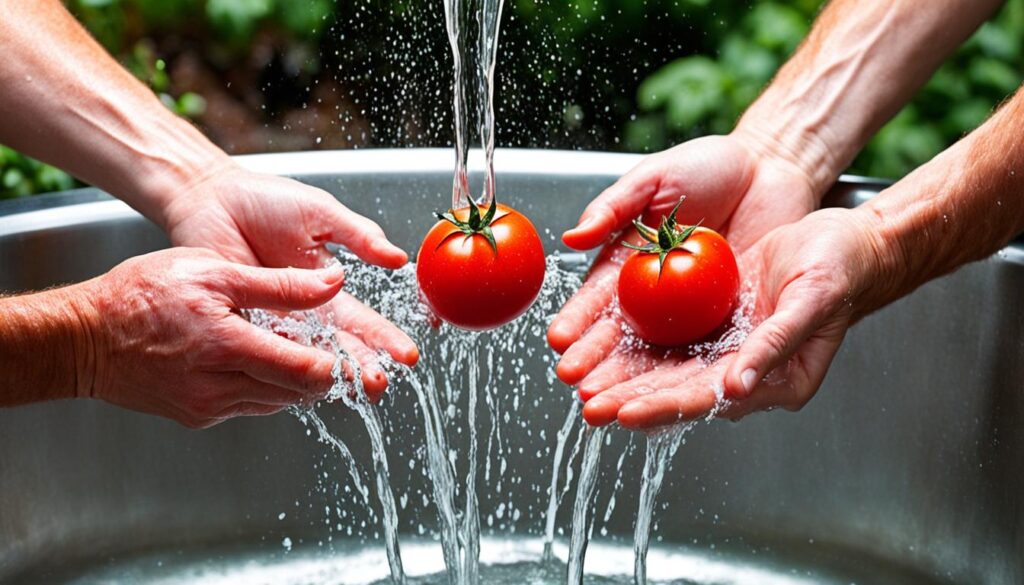
| Potential Spoilage Issue | Prevention Measure |
|---|---|
| Loss of liquid from jar after processing due to food being packed too tightly | Pack food loosely |
| Jar seals initially, then seal is broken because of organisms growing due to underprocessing | Proper processing and using sound jars |
| Cloudy liquids indicative of bacterial spoilage resulting from minerals in water or anti-caking agents from table salt | Use soft water and canning salt |
| Fermentation and gas in jar leading to broken seal with cheesy, alcoholic odor often due to yeast | Proper processing with heat destruction of yeast |
| Fuzzy growth on food surface, musty odor, sliminess from mold | Proper processing and reheating applesauce before jarring |
Contaminated tomatoes have been linked to incidents of food poisoning caused by Salmonella. Proper food handling and preparation techniques could prevent many foodborne illnesses.”
4. Ideal Storage Conditions
Storing tomatoes right is key to keeping them fresh and tasty. The right temperature and humidity are important. They help stop tomatoes from going bad and keep them fresh longer.
Temperature and Humidity Control
Ripe tomatoes should be kept cool, between 4-10°C (39-50°F). They need a humidity of 90-95%. This keeps their texture, taste, and nutrients good. Green tomatoes need a warmer spot, over 12°C (54°F), to ripen right.
Best Storage Locations
Keep tomatoes in a cool, dark spot, like a pantry or wine cellar. Don’t put them in the fridge, as it can make them taste bad. The fridge’s dry air makes tomatoes dry and lose their juiciness.
By storing tomatoes this way, they stay fresh and tasty for a long time. You can enjoy your harvest for weeks.
“The key to keeping tomatoes fresh is to maintain the right balance of temperature and humidity. Proper storage is crucial for preserving their flavor and texture.”
For more tips on storing different fruits and veggies, check out these links:
- Produce Storage Guide
- Storing Garden Fruits and Vegetables
- High-throughput Genotyping of Resilient Tomato Landraces
5. Using Appropriate Storage Containers
Storing tomatoes right is key to keeping them fresh. The kind of container you use matters a lot. It helps stop moisture from building up, which can cause tomatoes to spoil early.
Choosing Containers that Prevent Moisture Buildup
Stay away from airtight or plastic containers. They can trap too much moisture, leading to mold and spoilage. Go for containers that let air in instead. These include:
- Perforated plastic bags or containers
- Mesh or paper bags
- Cardboard boxes with holes for ventilation
- Wooden crates or baskets
Using Breathable Bags or Containers
Containers that breathe are key for keeping moisture levels right. They let air move around the tomatoes, keeping them fresh and tasty. Some good choices are:
- Perforated plastic bags or containers
- Mesh or burlap bags
- Cardboard boxes with holes for ventilation
- Wooden crates or baskets
Choosing the right containers and keeping air moving helps your tomatoes stay fresh. Aim for a balance that stops moisture from building up but still lets air in.
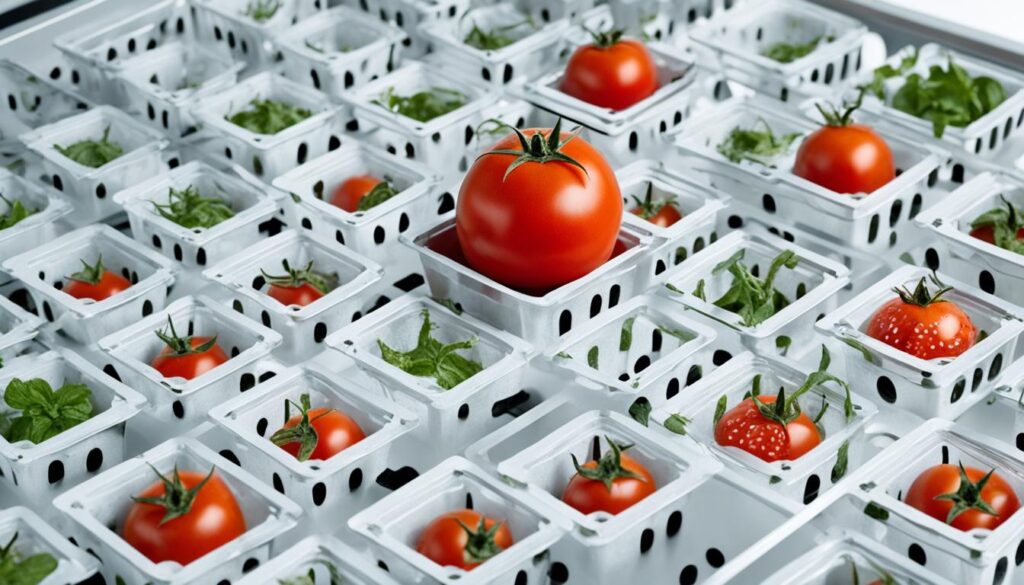
“Storing tomatoes in breathable containers is crucial for preserving their freshness and quality. Airtight options can lead to moisture buildup and spoilage, so it’s important to choose the right storage solution.”
For keeping tomatoes for a long time, think about canning, freezing, or other ways to preserve them. Look into what works best for you.
6. Avoiding Ethylene Exposure
Ethylene is a plant hormone that affects tomatoes’ storage life and quality. It’s important to know how ethylene works and store tomatoes away from fruits that produce a lot of it. This helps stop tomatoes from spoiling too soon.
Understanding Ethylene Gas and Its Effects
Ethylene gas makes many fruits and vegetables ripen, including tomatoes. Even a little bit of ethylene can make tomatoes ripen and spoil faster. It can make them overripe, soft, and lose their taste and texture too soon.
Storing Tomatoes Away from Ethylene-Producing Fruits
Keep tomatoes away from fruits that give off a lot of ethylene. These include:
- Bananas
- Apples
- Avocados
- Melons (such as cantaloupe, not watermelon)
- Tomatoes
Storing tomatoes away from these fruits helps them last longer and stay fresh. Also, keeping them cold slows down ethylene production, which also helps keep tomatoes fresh.
| Ethylene-Producing Fruits and Vegetables | Ethylene-Sensitive Produce |
|---|---|
| Bananas, apples, avocados, melons, tomatoes | Carrots, broccoli, greens, cucumbers |
Knowing about ethylene and how to store tomatoes can prevent spoilage. Using the right storage methods and keeping tomatoes away from ethylene fruits keeps them fresh longer. This is key for keeping tomatoes good to eat.
“Exposure to ethylene can cause broccoli and cabbage to yellow, cucumbers to pit, carrots to turn bitter, and affect lettuce, greens, and herbs’ color and freshness.”
7. Regularly Checking Stored Tomatoes
Keeping tomatoes fresh is key for any chef or produce lover. Regular checks help spot spoilage early and stop it from spreading. Here are tips to keep your tomatoes great:
Inspecting for Signs of Spoilage
Take time to look over your tomatoes for decay signs. Watch for mold, color changes, soft spots, or odd looks. If a tomato has broken skin, leaks, or smells bad, throw it out right away. This stops the problem from spreading.
Rotating Stock to Use Older Tomatoes First
Use a first-in, first-out (FIFO) system to use older tomatoes first. This cuts down on waste and keeps tomatoes fresh. Put new tomatoes behind the old ones to make sure they get used quickly.
By often checking stored tomatoes and rotating your stock, you can make your tomatoes last longer. Enjoy their taste and texture at their best. Remember, storing tomatoes right stops spoilage and keeps them good.
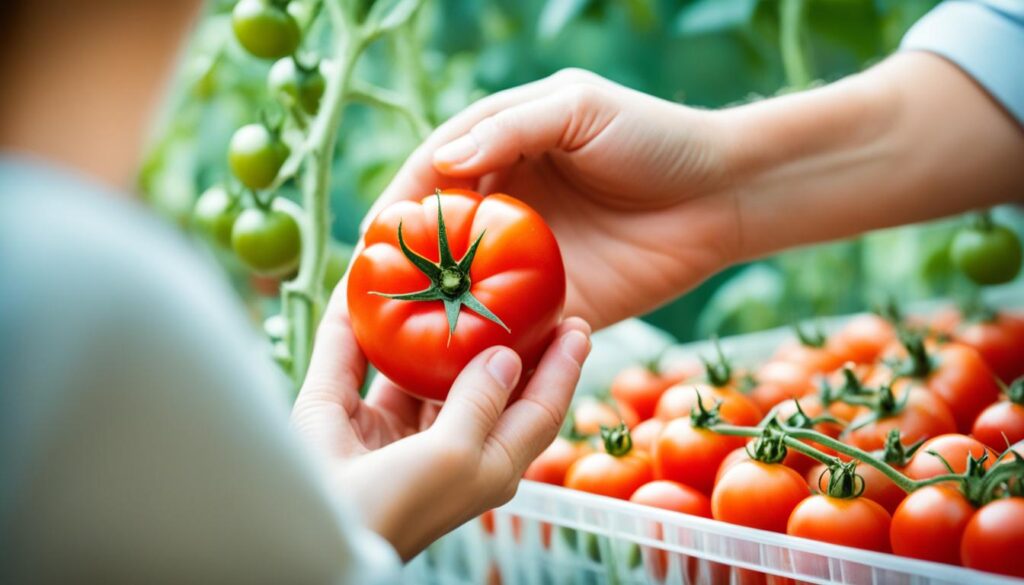
| Tomato Storage Tips | Recommended Practices |
|---|---|
| Ideal Temperature | 55°F to 70°F |
| Refrigerator Storage | Up to 2 weeks |
| Signs of Spoilage | Mold, discoloration, soft spots, unpleasant aroma |
| Stock Rotation | Use older tomatoes first (FIFO) |
Smelling a tomato to check for a pleasant tomato scent and weighing it in hand to assess ripeness are recommended methods for selecting fresh tomatoes at the store.
8. Preserving Tomatoes for Longer Storage
Tomatoes are a favorite in many kitchens, but they don’t last long. Luckily, you can keep them fresh for months with canning, vacuum sealing, and freezing.
Canning and Vacuum Sealing Techniques
Canning is a classic way to keep tomatoes fresh. It lets you enjoy their taste and nutrients for a long time. To can tomatoes safely, add citric acid or lemon juice to keep them acidic. The time you need to process them depends on where you live, from 40 to 100 minutes.
Vacuum sealing is another great way to keep tomatoes fresh. It takes the air out of the package, stopping germs from growing. You can store sealed tomatoes, whether whole or in pieces, for months in a cool, dark spot.
Freezing Tomatoes Properly
If you like to freeze tomatoes, there are steps to follow for the best results. You can freeze them whole, in pieces, or as sauce. Blanching and removing the skin helps keep them fresh when frozen. Freezing tomato sauces and purees is also a good idea for quick meals.
Choosing how to preserve tomatoes is important. Use ripe tomatoes and follow the right steps to enjoy summer’s taste all year.
| Preservation Method | Advantages | Considerations |
|---|---|---|
| Canning |
|
|
| Vacuum Sealing |
|
|
| Freezing |
|
|
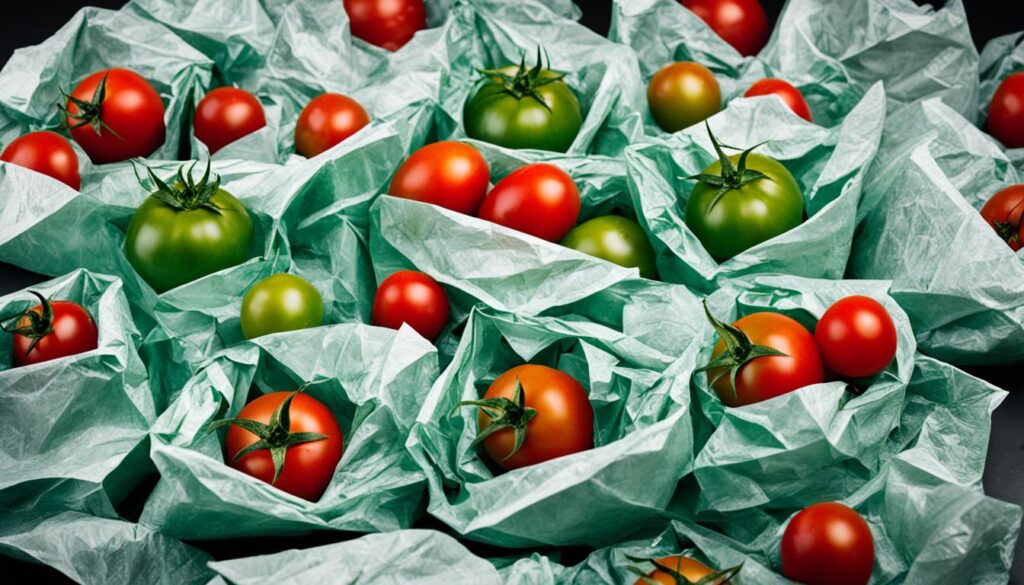
“Properly preserved tomatoes can be enjoyed all year round, bringing the taste of summer to your table even in the dead of winter.”
9. Dealing with Overripe Tomatoes
Even with the best storage, some tomatoes might get overripe. When this happens, use them right away. They spoil easily. Luckily, you can use these overripe tomatoes in many ways to avoid waste.
Using Overripe Tomatoes Immediately
Overripe tomatoes are great for many dishes. They’re perfect for sauces, soups, and stews because they’re soft and juicy. Just blend or chop them for a tasty base for many meals.
They also work well on bruschetta or roasted for salads and sandwiches.
Recipes and Ideas for Overripe Tomatoes
Got lots of overripe tomatoes? Try these tasty recipes and ideas:
- Tomato Soup – Blend overripe tomatoes with broth, herbs, and spices for a comforting and flavorful soup.
- Tomato Sauce – Cook down overripe tomatoes with garlic, onions, and your favorite seasonings for a homemade pasta sauce.
- Tomato Jam – Turn overripe tomatoes into a sweet and tangy jam for topping toast, crackers, or cheese.
- Tomato Salsa – Chop up overripe tomatoes and mix them with diced onions, cilantro, lime juice, and your desired seasonings for a flavorful salsa.
- Roasted Tomato Dip – Roast overripe tomatoes with garlic and herbs, then blend them into a creamy, savory dip.
Using overripe tomatoes can help reduce waste and make tasty dishes. They bring out the true flavor of this favorite fruit.
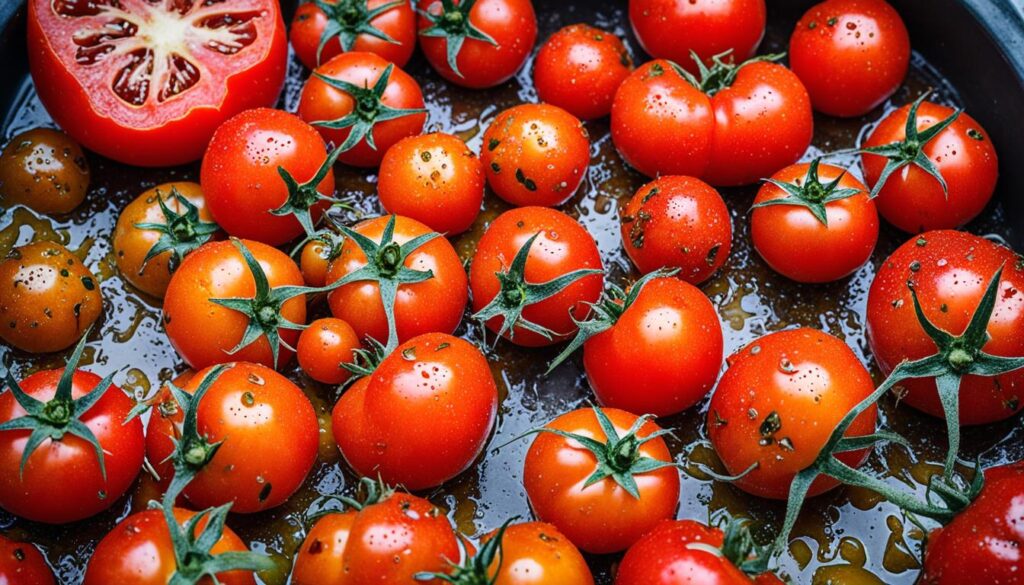
10. Hygiene and Sanitation Practices
Keeping storage areas clean is key to stopping germs and keeping tomatoes fresh longer. Clean all surfaces, tools, and containers that touch tomatoes. This helps avoid spoilage.
Keeping Storage Areas Clean
It’s important to clean storage areas often for tomato storage hygiene. Clean shelves, floors, and surfaces that touch tomatoes. Make sure the area is free from dust and things that could contaminate.
Sanitizing Tools and Containers
It’s also key to sanitize tools and containers used for tomatoes. This includes cutting boards, knives, and bins. Use approved cleaners and follow the instructions to keep them clean.
Good tomato storage hygiene and sanitation practices keep your tomatoes safe and fresh. Clean storage areas and sanitize tools to cut down on germs. This makes your tomatoes last longer.
“Proper food safety practices, including thorough cleaning and sanitization, are essential for preventing foodborne illness and maintaining the quality of stored produce.”
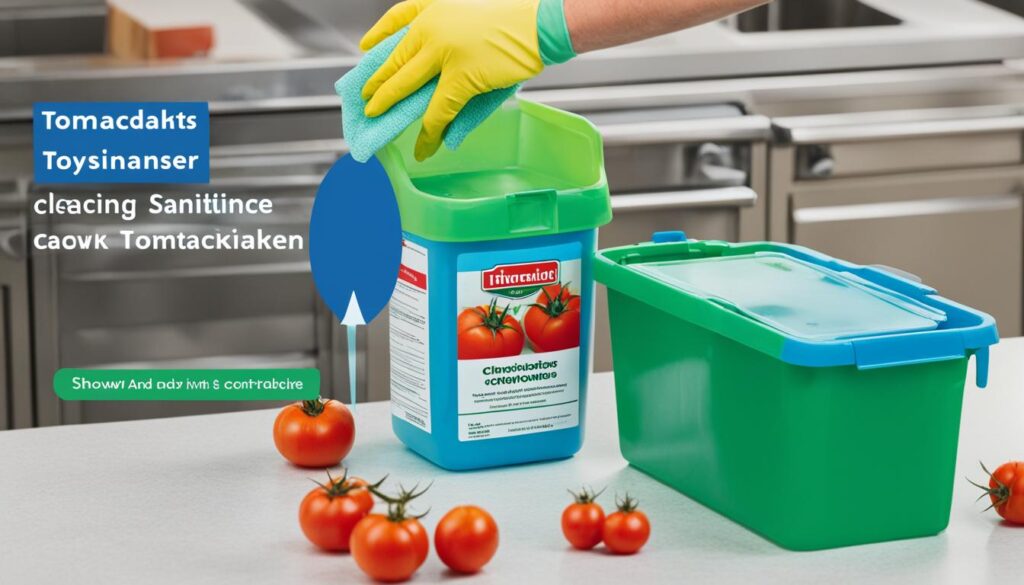
By following these tips for cleaning tomato storage areas and sanitizing tomato storage tools, your tomatoes will stay fresh and safe. Enjoy them with your family or customers.
Conclusion
In this article, we looked at how to keep tomatoes from spoiling. By following these tips, you can make your tomatoes last longer. This means you get to enjoy their fresh taste and quality for more time.
Recap of Best Practices
We talked about how to harvest and clean tomatoes right. We also discussed the best storage conditions and ways to keep them fresh. It’s important to check on your tomatoes often, move them around, and keep the storage area clean.
Encouragement to Implement These Practices
Using these tomato storage tips can cut down on food waste and save money. It also means you’ll have a steady supply of tasty, healthy tomatoes all season. By following these steps, you’ll get the most out of your tomatoes.
Final Tips for Keeping Tomatoes Fresh
Remember, storing tomatoes right is key to keeping them fresh. Always keep your storage area clean and look for more ways to keep tomatoes fresh. With these tips, you’ll enjoy your tomatoes for weeks.
FAQ
What are the key steps for preventing spoilage in stored tomatoes?
To prevent spoilage, start by harvesting tomatoes when they are ripe. Then, sort them to remove any damaged ones. Clean and dry the tomatoes well.
Store them in the right temperature and humidity. Use containers that keep moisture out. Keep them away from fruits that give off ethylene gas.
Check for spoilage often and rotate your stock. You can also keep tomatoes fresh by canning, vacuum sealing, or freezing them. Always keep your storage area clean and sanitized.
Why is proper storage crucial for extending the shelf life of tomatoes?
If tomatoes are not stored right, they can get moldy or go bad fast. This happens because of bad handling and storage. The right storage keeps tomatoes fresh for a longer time.
How do I identify the optimal ripeness for harvesting tomatoes?
Look for tomatoes with bright, even skin and a firm feel. Avoid any that are on the ground or look damaged. Handling them carefully during picking helps prevent damage.
What is the importance of inspecting and sorting tomatoes after harvesting?
It’s key to separate any tomatoes that are damaged. This stops them from making the healthy ones go bad faster. It keeps the good tomatoes fresh.
What are the best storage conditions for maintaining tomato freshness?
Store ripe tomatoes at 4-10°C (39-50°F) with 90-95% humidity. Keep unripe tomatoes above 12°C (54°F) to avoid damage. The best places are cool, dark spots like a pantry or wine cellar.
Refrigerators can make tomatoes taste and feel worse. So, it’s best to keep them there.
How can I prevent ethylene exposure from accelerating tomato spoilage?
Keep tomatoes away from fruits like apples, bananas, and avocados. These fruits give off ethylene gas. This gas can make tomatoes ripen and spoil faster.
What are some effective methods for preserving tomatoes for longer-term storage?
Canning and vacuum sealing can keep whole or diced tomatoes fresh. Freezing is great for saving the taste and texture of tomato sauces and purees.
How should I handle overripe tomatoes to prevent further spoilage?
Use overripe tomatoes right away. They spoil easily. You can add them to soups, sauces, or use them on bruschetta.
Why is maintaining a clean and sanitized storage environment important for preventing tomato spoilage?
A clean storage area helps stop germs from getting to tomatoes. This keeps them fresh longer. Make sure to clean and sanitize all surfaces and tools that touch the tomatoes.
Source Links
- Good Agriculture Practices for Tomatoes
- Retail Food Protection Storage and Handling of Tomatoes Manual
- The Best Ways to Preserve Your Tomato Harvest | Glenside, PA
- Microbial Assessment of Tomatoes (Lycopersicon esculentum) Sold at Some Central Markets in Ghana
- National Center for Home Food Preservation – National Center for Home Food Preservation
- How (and When) to Harvest Tomatoes | Planet Natural
- Harvesting Tips For Tomato – Kisanvedika | BigHaat
- Harvest at the Right Time
- Microsoft Word – 2008 ffh can ftv.doc
- Managing Tomato Diseases, Disorders, and Pests
- Will Those Green Tomatoes Turn Red?
- Canned Fruits and Tomatoes: Problems and Solutions (SP 50-743)
- Canning Tomatoes and Tomato Products – 9.341 – Extension
- Produce Storage Guide for Restaurants
- Storing Garden Fruits and Vegetables
- Effect of Elevated Temperature on Tomato Post-Harvest Properties
- Preserving Tomatoes
- Preserving Tomatoes at Home | New Mexico State University
- How to Store Tomatoes So They Stay Plump & Fresh for a Very Long Time
- No title found
- Which fruits and vegetables should and shouldn’t be stored together
- 3 Easy Tips to Never Picking a Mealy or Rotten Tomato at the Store
- This Trick for Storing Tomatoes Helps Keep Them Fresh and Flavorful for More Than a Week
- How to properly store tomatoes so they last a really long time
- How to Preserve Tomatoes
- Harvesting and Preserving Tomatoes for Long Storage
- Let’s Preserve: Tomatoes
- Tomato Diseases | Piedmont Master Gardeners
- Tomato Diseases & Disorders
- Is That Tomato Rotten Or Is It Safe to Eat?
- Preventing Foodborne Illness
- Restaurant Tomatoes: Best Practices in the BOH | The Official Wasserstrom Blog
- Knowledge, attitude and practice of tomato retailers towards hygiene and food safety in Harar and Dire Dawa, Ethiopia
- Preservation of Lycopersicum esculentum (Tomatoes) with Extracts of Annona muricata (Soursop) and Hibiscus sabdariffa (Roselle Plant)
- Canning Tomatoes: Do’s and Don’ts
